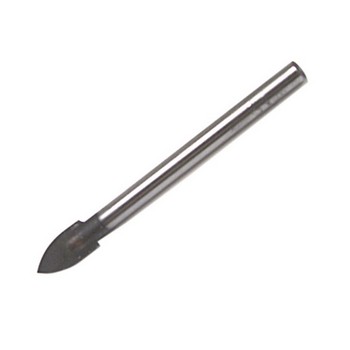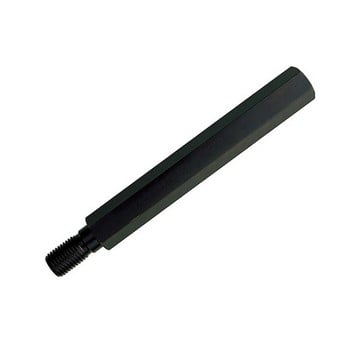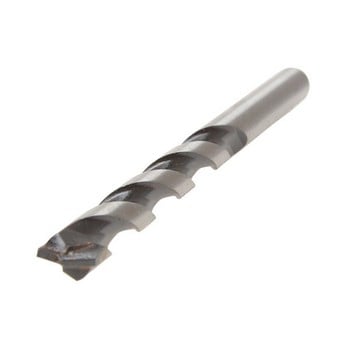Glass, Tile, Core & Diamond Drill Bits
Find out more about Glass, Tile, Core & Diamond Drill Bits
Glass, tile, core, and diamond drill bits are specialised tools designed for specific drilling applications, each offering unique features to achieve optimal results.
Glass Drill Bits: These bits are designed with a sharp, pointed tip that helps prevent cracking and chipping when drilling into glass. They typically have a smooth, non-abrasive surface to ensure clean holes without damaging the material. Glass drill bits are perfect for tasks like installing fixtures or creating decorative designs in glass.
Tile Drill Bits: Similar to glass bits, tile drill bits are made to drill through ceramic and porcelain tiles. They often feature a spear-shaped tip or a carbide-tipped design to penetrate hard surfaces without causing breakage. These bits are essential for home improvement projects involving tile installation, allowing for precise holes for plumbing or electrical work.
Core Drill Bits: Core bits are designed for drilling larger holes in various materials, including concrete, brick, and masonry. They have a cylindrical shape with a hollow centre, allowing them to remove a core of material as they drill. This makes them ideal for creating openings for pipes, conduits, or other installations in construction and renovation projects.
Diamond Drill Bits: Known for their durability and effectiveness, diamond drill bits are embedded with diamond particles, making them suitable for cutting through hard materials like concrete, stone, and glass. They provide clean, precise holes and are often used in professional settings for heavy-duty applications. Diamond bits can be used wet or dry, depending on the material and desired finish.
Each type of drill bit serves a specific purpose, and selecting the right one is crucial for achieving the best results in your projects.
Glass, Tile, Core & Diamond Drill Bits FAQs
What materials can glass drill bits be used on?
Glass drill bits are specially designed for drilling into delicate and hard surfaces without causing cracks or shattering. While they are optimised for glass, their unique features make them suitable for a range of materials. Here's a list of materials they can be used on:
1. Glass
Ideal for drilling holes in flat or curved glass surfaces such as windows, mirrors, and bottles.
Used in applications like creating decorative glass items, mounting hardware, or making crafts.
2. Ceramic Tiles
Perfect for precision drilling in ceramic tiles for installing fixtures, shelves, or decorative elements.
Reduces the risk of chipping or cracking during drilling.
3. Porcelain
Suitable for dense porcelain surfaces, such as sinks or tiles.
Essential for smooth and clean cuts without damage to the material.
4. Marble
Can be used to drill into soft to medium-hard marble for construction or decorative purposes.
Ensures precision without excessive wear on the bit.
5. Slate and Stone
Useful for softer stones like slate in flooring or wall applications.
Requires proper technique and lubrication for best results.
6. Acrylic and Plastics
Can be used for precision work on acrylic or hard plastics, often in craft or DIY projects.
Important Tips for Use:
Lubrication: Always use water or a suitable lubricant to keep the bit cool and reduce the risk of damage to the material.
Low Speed: Operate at low drill speeds to maintain control and prevent overheating.
Proper Technique: Apply gentle, steady pressure to avoid cracking delicate surfaces.
In summary, glass drill bits are versatile tools capable of handling fragile materials like glass and tiles, as well as harder surfaces like marble and porcelain, when used with care and the correct techniques.
How do I prevent cracking when using tile drill bits?
Preventing cracking when drilling into tiles requires the right tools, techniques, and precautions. Here’s a step-by-step guide to help ensure smooth, crack-free drilling:
1. Use the Right Tools
Tile Drill Bits: Use specialised tile drill bits, such as diamond-tipped or tungsten carbide-tipped bits, designed for hard surfaces.
Variable Speed Drill: A drill with adjustable speed settings allows for better control during the process.
2. Prepare the Tile
Clean the Surface: Wipe the tile clean to remove any dust or debris that could interfere with the drilling process.
Mark the Spot: Use masking tape to cover the area where you plan to drill. This helps prevent the bit from slipping and reduces stress on the tile. Mark the drilling point on the tape for accuracy.
3. Start Drilling Correctly
Drill at a Low Speed: Begin drilling at a low speed to avoid sudden pressure on the tile. Increase the speed slightly as the bit starts to penetrate.
Use Minimal Pressure: Let the drill do the work. Applying too much pressure can cause the tile to crack.
4. Keep the Bit Cool
Use Water or Lubricant: Constantly cool the drill bit by spraying water or using a damp sponge near the drilling site. This prevents overheating, which can crack the tile.
Take Breaks: If drilling a thick or tough tile, pause periodically to let the bit and tile cool.
5. Use Proper Drilling Angle
Start at an Angle: Begin drilling at a 45-degree angle to create a small dent. Then gradually straighten the drill to 90 degrees to finish the hole. This prevents the bit from slipping and distributes force evenly.
6. Finish Carefully
Slow Down Near the End: As the bit nears the back of the tile, reduce pressure to avoid breaking through too quickly, which could cause cracking.
Support the Tile: If drilling on a loose tile, support it with a sturdy surface to prevent movement or stress.
7. Safety Precautions
Wear Safety Gear: Use safety goggles and gloves to protect against flying shards and sharp edges.
Check Behind the Tile: Ensure no pipes or cables are behind the drilling area.
By following these tips, you can effectively drill into tiles without cracking, ensuring a clean and professional finish for your project.
What is the difference between core drill bits and standard drill bits?
Core drill bits and standard drill bits differ in design, function, and application. Here’s a breakdown of their key differences:
1. Design and Structure
Core Drill Bits:
Hollow Cylinder: Features a hollow center, designed to cut a circular hole and extract a "core" of the material being drilled.
Segmented Teeth: Often equipped with diamond or carbide segments at the edge for cutting hard materials like concrete, stone, or masonry.
Large Diameter Options: Available in larger diameters, suitable for making big holes.
Standard Drill Bits:
Solid Shank: A fully solid structure with cutting edges at the tip.
Variety of Tips: Includes twist bits, spade bits, and masonry bits, each designed for specific materials like wood, metal, or plastic.
Smaller Diameter Range: Generally used for smaller, more precise holes.
2. Functionality
Core Drill Bits:
Material Removal: Cuts around the perimeter of the hole, leaving the center (core) intact, which can be removed after drilling.
Efficient for Large Holes: Ideal for creating large-diameter holes without removing the entire material inside the cut area.
Non-Destructive: Minimises material waste, often used for plumbing, HVAC, or electrical installations.
Standard Drill Bits:
Material Removal: Cuts and removes all material from the drilled hole, creating a solid bore.
Precise Drilling: Suited for smaller, detailed holes and general-purpose use.
3. Applications
Core Drill Bits:
Construction and Utility Work: Used for drilling through concrete, stone, or brick to create openings for pipes, wiring, or ventilation ducts.
Specialised Projects: Often used in tasks requiring precision and minimal disruption, such as extracting material samples in geology or engineering.
Standard Drill Bits:
General Use: Suitable for a wide range of materials, including wood, plastic, metal, and masonry.
DIY and Light-Duty Work: Common in home improvement and smaller-scale projects.
4. Drilling Tools Compatibility
Core Drill Bits:
Typically used with core drilling machines or heavy-duty hammer drills with appropriate adapters.
Requires more powerful tools due to their size and the materials they target.
Standard Drill Bits:
Compatible with most standard drills and suitable for handheld drills, drill presses, or power screwdrivers.
5. Cost
Core Drill Bits: More expensive due to their specialised design and use of premium materials like diamond-tipped edges.
Standard Drill Bits: More affordable and widely available for general applications.
Summary
Core Drill Bits: Ideal for creating large, precise holes in hard materials, with minimal waste.
Standard Drill Bits: Versatile and suitable for smaller, precise holes in a variety of materials.
Choosing the right type depends on your project needs and the materials you’re working with.
Can diamond drill bits be used on metal?
While diamond drill bits are primarily designed for hard materials like stone and concrete, some can be used on metal. However, it's generally best to use bits specifically made for metal to achieve optimal results.
Do I need to use water with diamond drill bits?
Yes, using water with diamond drill bits is highly recommended. Water helps to cool the bit, reduce friction, and minimise dust when drilling, which can prolong the life of the bit and improve drilling efficiency. It also helps prevent overheating, especially when drilling through harder materials.
How do I clean and maintain my drill bits?
To clean and maintain your drill bits, follow these steps:
Remove Debris: After use, remove any debris or material stuck to the bit by gently brushing it with a soft-bristle brush or cloth.
Soak in Solution: For tougher residue, soak the drill bits in a solution of warm water and mild soap for a few minutes. This can help loosen any stubborn dirt.
Rinse and Dry: Rinse the bits thoroughly with clean water to remove soap and debris, then dry them completely with a towel to prevent rust.
Lubricate: Apply a light coat of machine oil or lubricant to the metal parts of the drill bits to prevent corrosion and keep them in good condition.
Store Properly: Store your drill bits in a dry place, preferably in a protective case or a designated drill bit holder to avoid damage.
Regular maintenance will help extend the life of your drill bits and ensure they perform well when you need them.
What sizes do these drill bits come in?
Drill bits come in a wide range of sizes, typically measured in inches or millimetres. Here are some common sizes you might encounter:
Fractional Sizes: These are often used in standard drill bits and can range from as small as 1/16 inch to larger sizes like 1 inch or more.
Metric Sizes: Metric drill bits usually range from 1 mm to 25 mm or larger, depending on the type of bit.
Specialty Sizes: Some drill bits, like those for specific applications (e.g., for pilot holes or countersinks), may come in unique sizes tailored to particular tasks.
When choosing a drill bit, it's important to select the right size for the project you're working on.
Can I use a regular drill for these types of bits?
Yes, you can use a regular drill for many types of drill bits, including standard twist bits and some specialty bits. However, for certain types of bits, like larger hole saws or core bits, you might need a more powerful drill or a hammer drill to handle the increased torque and pressure. Always check the manufacturer's recommendations for the specific bit you're using to ensure compatibility with your drill.





Shop our wide range of Glass, Tile, Core & Diamond Drill Bits at Trading Depot. Explore high-performance Glass, Tile, Core & Diamond drill bits, ideal for precision drilling in hard, brittle surfaces like glass, tile, ceramics, and stone. Designed with ultra-durable diamond or carbide tips, these drill bits offer clean, accurate holes without cracking or chipping, making them perfect for both DIY and professional applications. With a range of sizes to suit various projects, these bits are engineered for smooth, fast drilling and long-lasting performance, even on the toughest materials. Achieve flawless results with these specialist drill bits, a must-have for any tool kit handling delicate or challenging surfaces.